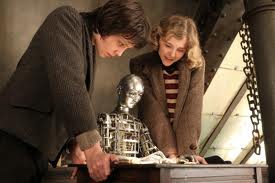 Martin Scorsese has long been regarded as a great American filmmaker of astounding talent. With his latest film, Hugo (adapted from the children’s novel The Invention of Hugo Cabret), he has indelibly established himself as a master filmmaker, one whose repetoire continues to expand. Hugo is the movie that we’d least expect from the man; it’s also the one that probably tells us the most about him.
Martin Scorsese has long been regarded as a great American filmmaker of astounding talent. With his latest film, Hugo (adapted from the children’s novel The Invention of Hugo Cabret), he has indelibly established himself as a master filmmaker, one whose repetoire continues to expand. Hugo is the movie that we’d least expect from the man; it’s also the one that probably tells us the most about him.
A tale bordering on magical realism, it gives us the story of a young boy (Asa Butterfield), an orphan living behind the walls and in the large clock of a Paris train station circa the 1930s. In between secretly maintaining the clock to keep the loutish station guard (Sascha Baron Cohen) from catching him and shipping him off to an orphanage, he also tinkers with a clockwork man that he and his late father (Jude Law) were restoring before the latter’s untimely death. This involves stealing spare parts from a toy shop run by an old man, Georges (Ben Kingsley).
Hugo is of course caught by Georges, who seems deeply upset by the contents of a notebook he confiscates from the boy — his last link to his late father, containing details on their automaton. Hugo begins working for Georges and an assistant, paying off the parts he stole in order to regain his notebook. He meets Georges ward, a spirited young girl named Isabelle (Chloe Grace Moretz) and the two share their secrets and introduce each other to their respective worlds; his of movies, hers of books. Some chance encounters reveal to them the secrets of Georges’ remarkable past and deep sadness. (His true identity will not be revealed here.)
It’s a simple, intimate tale that becomes engrossing, emotionally gripping, and almost epic. It’s also Scorsese’s love letter to his craft. (A deeply religious man, he once stated “The two most important things in my life are my religion and my art.”) Specifically, he celebrates the thrill of discovery that defined the birth of film and the earliest days of the silent film era — so close to being lost and forgotten by modern audiences — and he does it in a way that makes wonder contagious.
Scorsese makes use of 3-D filmmaking for the first time in his career, and his approach to the format is elegant and creative, as well as appropriate. The very first film ever shown, the 48-second short “Arrival of a Train at La Ciotat” by the Lumiere Brothers (1896), panicked audiences who half expected to be run over; Scorsese recreates that moment in more ways than one, and they are a few of several such odes to the old masters.
As with many auteurs, film history is what makes Scorsese tick, and in Hugo he gives audiences just enough insight into a bygone and increasingly overlooked era to excite them and arouse their curiosity. Much like the title character, he restores a forgotten pioneer to his former glory, and pays homage to the forefather of modern film. “Do you wonder where dreams come from?” asks Georges late in the movie. “This is where they’re made.”





